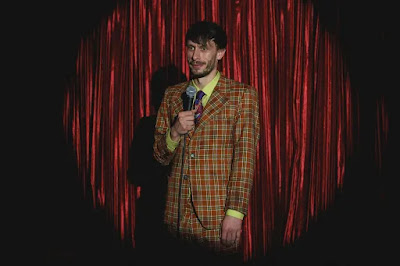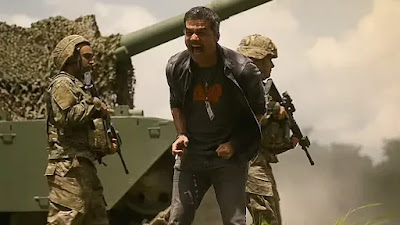E não se esqueçam de curtir e seguir o blog nas redes sociais:
(And don't forget to like and follow the blog in social medias:)
Facebook: https://www.facebook.com/NoCinemaComJoaoPedroBlog/
Twitter/X: @nocinemacomjp2
Instagram: @nocinemacomjpblog
YouTube: https://youtube.com/@nocinemacomjp
Um festival pouco comentado que deveria receber mais atenção é o Festival de Annecy. Um dos principais eventos internacionais sobre animação, o festival foi fundado em 1960, na cidade francesa de Annecy. Inicialmente, o evento ocorria uma vez a cada dois anos; porém, a partir de 1998, ele passou a ter uma frequência anual. Hoje em dia, Annecy não só serve como uma plataforma para que os maiores estúdios mostrassem prévias de seus vindouros trabalhos, como também oferece uma mostra competitiva composta por longas-metragens dos mais variados países e métodos de animação. Alguns dos vencedores dos principais prêmios de Annecy foram indicados ao Oscar de Melhor Filme de Animação, como “Coraline e o Mundo Secreto”, “O Fantástico Sr. Raposo” e até o brasileiro “O Menino e o Mundo”, de Alê Abreu. Então, na postagem de hoje, irei listar cinco destaques para ficar de olho presentes na edição de 2024 do Festival de Annecy, que ocorreu entre os dias 9 e 15 de junho. Vamos lá!
(A lesser-known festival that should get more attention is the Annecy International Animation Film Festival. One of the main international events on animation, the festival was founded in 1960, in the French town of Annecy. Initially, the event occurred once every two years; however, starting in 1998, it went on to have an annual frequency. Nowadays, Annecy not only serves as a platform for the biggest studios to show sneak previews of their upcoming work, as it also offers a competitive showcase composed by feature films from a wide variety of countries and animation methods. Some of the winners of the main awards from Annecy were nominated for the Oscar for Best Animated Feature, such as “Coraline”, “Fantastic Mr. Fox” and even the Brazilian feature “Boy and the World”, by Alê Abreu. So, in today's post, I'll list five highlights to keep an eye out for from the 2024 edition of the Annecy Film Festival, which occurred between June 9 and 15. Let's go!)
“MEMOIR OF A SNAIL”, dirigido por Adam Elliot
(“MEMOIR OF A SNAIL”, directed by Adam Elliot)
15 anos após sua primeira obra-prima, “Mary e Max: Uma Amizade Diferente”, premiado em Annecy, o australiano Adam Elliot retorna com seu segundo longa-metragem em stop-motion, “Memoir of a Snail” (Memórias de um Caracol, em tradução livre). Vencedor do Prêmio Cristal de Melhor Longa-Metragem no Festival, o longa de Elliot é ambientado na Austrália dos anos 1970, e acompanha Grace, uma garota cuja vida é conduzida por uma série de tragédias. Quando sua mãe morre durante o parto, Grace e seu irmão gêmeo Gilbert vão morar com seu pai, Percy, um ex-malabarista paraplégico alcoólatra, e encontram a família que tanto desejavam. Porém, quando Percy falece durante o sono, Grace e Gilbert são separados um do outro e colocados em lares adotivos. As primeiras imagens liberadas lembram muito o trabalho do cineasta em “Mary e Max”, com a adição de um pouco mais de cor. O elenco de vozes conta com nomes renomados como Sarah Snook (“Succession”), Eric Bana (“Hulk”), Jacki Weaver (“O Lado Bom da Vida”), Kodi Smit-McPhee (“Ataque dos Cães”) e Dominique Pinon (“O Fabuloso Destino de Amélie Poulain”). Todos estes fatores prometem uma ótima segunda empreitada para Elliot.
(Fifteen years after his first masterpiece, “Mary and Max”, awarded in Annecy, the Australian filmmaker Adam Elliot returns with his second feature-length stop-motion film, “Memoir of a Snail”. Winner of the Cristal Award for Best Feature Film in the Festival, Elliot's film is set in 1970s Australia, following Grace, a girl whose life is conducted by a series of tragedies. When her mother dies during childbirth, Grace and her twin brother Gilbert go on to live with their father, Percy, a paraplegic, alcoholic former juggler, where they find the family they longed for forever. However, when Percy passes away during his sleep, Grace and Gilbert are separated from each other and thrust into foster homes. The first images released are very reminiscent of the filmmaker's work in “Mary and Max”, with the addition of a little bit more of color. The voice cast relies on industry names like Sarah Snook (“Succession”), Eric Bana (“Hulk”), Jacki Weaver (“Silver Linings Playbook”), Kodi Smit-McPhee (“The Power of the Dog”) and Dominique Pinon (“Amélie”). All these factors promise a great second outing for Elliot.)
“FLOW”, dirigido por Gints Zilbalodis
(“FLOW”, directed by Gints Zilbalodis)
Aclamado em suas primeiras exibições no Festival de Cannes, o segundo longa-metragem do cineasta letão Gints Zilbalodis, “Flow” (Fluxo, em tradução livre), venceu tanto o Prêmio do Júri quanto o Prêmio do Público no Festival de Annecy, já despontando como um dos favoritos ao Oscar 2025 de Melhor Filme de Animação. Acompanhando a jornada de um gato que navega por uma cidade alagada em um barco, encontrando outros animais no decorrer da trajetória, “Flow” conquistou o coração dos críticos por seu belíssimo trabalho de animação e sua narrativa emocionante, que transmite mensagens humanas por meio de seus personagens animais. Vale a pena ressaltar que, assim como o primeiro filme de Zilbalodis, “Away”, no qual o diretor foi o único animador, “Flow” não tem diálogos, com o visual e a trilha sonora carregando todo o peso narrativo e emocional que a trama deseja passar. Caso queiram ver um clipe, podem fazê-lo neste link.
(Acclaimed in its first screenings in the Cannes Film Festival, the second feature film by Latvian filmmaker Gints Zilbalodis, “Flow”, won both the Jury Prize and the Audience Award in the Annecy Film Festival, already stepping up to be one of the favorites in the race for next year's Oscar for Best Animated Feature. Following the journey of a cat who sails across a flooded city on a boat, finding other animals throughout his traveling, “Flow” won over critics' hearts for its gorgeous work in animation and its emotional narrative, which conveys human messages through its animal characters. It's worth mentioning that, like Zilbalodis's first film, “Away”, in which the director was the sole animator, “Flow” has no dialogue, with the visuals and score carrying all the narrative and emotional weight the plot wishes to convey. If you'd like to see a clip, you can do it in this link.)
“SAVAGES”, dirigido por Claude Barras
(“SAVAGES”, directed by Claude Barras)
Assim como as obras supracitadas, “Savages” (Selvagens, em tradução livre) marca o retorno de mais uma voz promissora na animação. Após o surpreendente sucesso do criminalmente subestimado (e indicado ao Oscar) “Minha Vida de Abobrinha”, o suíço Claude Barras retorna à direção com seu terceiro longa-metragem em stop-motion, que acompanha Kéria, uma garota suiça que vive com seu pai em uma província na ilha de Bornéu e adota um bebê orangotango como animal de estimação. Quando a prima de Kéria é expulsa de seu lar por causa do desmatamento, passando a morar com ela e seu pai, as duas crianças e o orangotango se veem forçadas a lutar contra as companhias de exploração madeireira. Barras fez um incrível trabalho com a temática familiar em “Minha Vida de Abobrinha”, e ele parece repetir o feito com seu novo filme, acrescentando a exploração sempre necessária dos efeitos do desmatamento no meio ambiente e os danos que ele causa à natureza e à população de seus ecossistemas. Assim como “Flow”, “Savages” foi aclamado no Festival de Cannes, onde os críticos destacaram a triste realidade da narrativa por trás da belíssima animação da obra, uma qualidade que a torna ainda mais impactante.
(Just like the aforementioned works, “Savages” marks the return of yet another promising voice in animation. After the astounding success of the criminally underrated (and Oscar-nominated) “My Life as a Zucchini”, Swiss filmmaker Claude Barras returns to direct his third stop-motion feature-length film, which follows Kéria, a Swiss girl who lives with her father in a province in the island of Borneo and adopts a baby orangutan as a pet. When Kéria's cousin is kicked out of her home due to deforestation, starting to live with her and her father, the two children and the orangutan see themselves forced to fight against the logging companies. Barras did an amazing job with the family theme in “My Life as a Zucchini”, and he seems to have repeated that feat with his new film, adding the ever-necessary exploration of the effects of deforestation in the environment and the damages it causes to nature and the population of its ecosystems. Like “Flow”, “Savages” was acclaimed in the Cannes Film Festival, where critics highlighted the narrative's sad reality behind the work's gorgeous animation, a quality that makes it all the more impactful.)
“THE COLORS WITHIN”, dirigido por Naoko Yamada
(“THE COLORS WITHIN”, directed by Naoko Yamada)
A animação japonesa têm alcançado um novo nível de público recentemente, com a disponibilidade dos filmes do Studio Ghibli em serviços de streaming, a vitória de “O Menino e a Garça” no Oscar e a distribuição de filmes de franquias como “Demon Slayer” e “Haikyuu!” pela Sony. “The Colors Within” (As Cores Dentro de Nós, em tradução livre) promete ser mais um sucesso neste meio, por vários fatores. O primeiro é a direção de Naoko Yamada, responsável por um dos animes mais aclamados e emocionantes dos últimos tempos, “A Voz do Silêncio”. O segundo é a trama, que assim como o filme supracitado, também envolve adolescentes, acompanhando uma estudante que consegue ver as “cores” daqueles ao seu redor, representando sentimentos como a angústia, o ânimo e a calma. Ao criar uma banda com duas outras colegas, a música as une, ao mesmo tempo que mexe com os sentimentos de cada uma. O terceiro fator é a animação, que fica por conta do estúdio Science SARU, responsável pela pérola escondida que é “Scott Pilgrim: A Série” na Netflix. A GKIDS, distribuidora dos filmes do Studio Ghibli nos EUA, adquiriu os direitos globais de “The Colors Within” após a exibição em Annecy, então já podemos esperar mais uma história emocionante e visualmente impactante sobre adolescentes em breve!
(Japanese animation has reached a whole new level of audience recently, with the availability of Studio Ghibli's films in streaming services, “The Boy and the Heron”'s win at the Oscars and the distribution of films of franchises like “Demon Slayer” and “Haikyuu!” by Sony. “The Colors Within” promises to be another hit in this medium, over a series of factors. The first is the direction by Naoko Yamada, who's responsible for one of the most acclaimed and emotional anime films lately, “A Silent Voice”. The second is the plot, which just like that film, also involves teenagers, following a high school student who can see the “colors” of those around her, representing feelings like angst, excitement and serenity. When she forms a band with two other classmates, music brings them together, at the same time it stirs each one's affections. The third factor is the animation, which is made by the studio Science SARU, responsible for the hidden gem that is “Scott Pilgrim Takes Off” on Netflix. GKIDS, who distributes Studio Ghibli's films in the US, has acquired global rights to “The Colors Within” after its screening at Annecy, so we can expect to have another emotional and visually impactful coming-of-age story soon!)
“TOTTO-CHAN: THE LITTLE GIRL AT THE WINDOW”, dirigido por Shinnosuke Yakuwa
(“TOTTO-CHAN: THE LITTLE GIRL AT THE WINDOW”, directed by Shinnosuke Yakuwa)
Vencedor do Prêmio Paul Grimault de Annecy, batizado em homenagem à um dos maiores animadores da França, “Totto-chan: The Little Girl at the Window” (Totto-chan: A Garotinha na Janela) é baseado em uma história real, tomando inspiração no livro de memórias de mesmo nome de Tetsuko Kuronayagi. Ela é uma das personalidades televisivas mais famosas do Japão, cujo programa “Tetsuko's Room” se tornou uma marca registrada da programação de TV no país. O longa de Shinnosuke Yakuwa acompanha uma garota de sete anos, fascinada com o mundo ao seu redor. Porém, este fascínio faz com que ela seja expulsa da escola, sendo encaminhada para um colégio de educação especial no processo. Lá, as crianças são livres para explorarem à vontade, e Totto-chan conhece crianças únicas e aprende um bocado de coisas interessantes. Mas tudo começa a mudar quando os primeiros efeitos da Segunda Guerra Mundial se tornam visíveis no país. O visual da animação evoca tanto os trabalhos clássicos do Studio Ghibli como também obras mais recentes, como “SPYxFAMILY”. A história promete ser muito tocante, em particular com o assunto em pauta da educação especial. E o fato de ser uma história real faz a obra por completo, que já parece ser excelente, parecer ainda mais impactante.
(Winner of the Paul Grimault Award in Annecy, named in homage to one of France's greatest animators, “Totto-chan: The Little Girl at the Window” is based on a true story, taking inspiration from the memoir of the same name by Tetsuko Kuronayagi. She is one of the most famous TV personalities in Japan, whose show “Tetsuko's Room” became a staple in the country's TV programming. Shinnosuke Yakuwa's film follows a seven-year-old girl, who's fascinated with the world around her. However, this fascination leads her to being expelled from school, being enrolled into a special education institution in the process. There, the kids are free to explore at their own will, and Totto-chan meets unique children and learns a handful of interesting things. But everything starts to change when the first effects of World War II become visible in the country. The animation's visuals evoke both Studio Ghibli's classic works and more recent shows, such as “SPYxFAMILY”. The story promises to be very touching, particularly with the approached subject of special education. And the fact that it's a true story makes the film as a whole, which already looks excellent, seem all the more impactful.)
É isso, pessoal! Espero que tenham gostado! Até a próxima,
João Pedro
(That's it, guys! I hope you liked it! See you next time,
João Pedro)
























